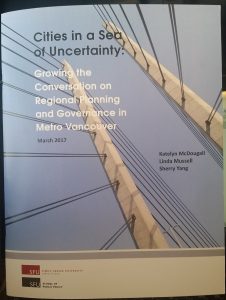With a busy schedule at the city, and so much election-related angst and chatter and tension and fluff, I found a way to be inspired and challenged in the most positive way on Thursday.
The City Program at Simon Fraser University and the SFU Centre for Dialogue hosted a constructive dialogue on the topic of the Regional Plan, or more on the very topic of regional planning in a Metro Vancouver context. The guiding questions for a compelling 4 hour conversation were:
Is this vision of “Cities in a Sea of Green” still appropriate? Will it sustain us for the next half century? What are the issues our vision must address if it is going to continue to serve the region?
In the room were about two dozen regional leaders from academia, activists and community conversation leaders, planners new and old, and a couple of elected types, both new and old. I would love to list resumes, and attribute quotes (there were many great quotable moments), but the program was run under Chatham House Rule, in order to facilitate freer dialogue. There will be reporting out via the City Program, but what that looks like probably depends on where this new dialogue leads.
In as short a summary as I can muster, my read of the feeling in the room was that the vision and the resultant Regional Plans have served the region well, even as the populations rise, the economy boomed and busted, our economic drivers shifted, and public transit replaced freeways as the ideal connector between city centres. However, there are many flaws in its applicaiton, and many of the current crises challenging the region (affordability, transportation, increasing social alienation) have at least partial connections to the vision itself. The consideration of keeping this vision or developing a new one needs to be measured against its ability to adress our new pressures. There was a broad consensus that this is the time for the Region to be having this conversation, as the pressures right now feel large enough to shift the region in pretty fundamantal ways. I was driven to think about our beautiful, admired, and unique region as being on a precipice.
Instead of trying to summarize the entire diverse conversation here, I would like to touch on just a few points that really hit me.
The conversation we prefaced by a report by a small group of grad students from SFU that looked at the history of regional planning in Greater Vancouver, and the pressures on the current plan:

The historic timeline was interesting. A few burgeoning communities collaborating on water and sewer systems in the first half of the last century prefaced an initial dabbling in regional landuse planning driven by the disastrous flood of 1948, but the first comprehensive regional growth strategy emerged in 1966 (where the vision “Cities in a Sea of Green” was first codified). This vision was still of town centers (Vancouver, Surrey, New Westminster, Langley, etc. separated by greenspace and agricultural lands, tied together by freeways, as was the ethos of the day.
The complex history since this time has involved complex relationships between the province and the local government leaders – and there were great forward moves (The 1973 establishment of the ALR, formation of the GVRD, the 1975 Livable Region Plan and 1996 Livable Region Strategic Plan, the 1998 formation of TransLink) and equally important slips backwards (Bill 9 in 1983, which abolished the regional planning function, the 2007 stripping of local governance of TransLink). Tried as I might, I couldn’t correlate the emphasis on regional planning with anything (resource industry boom-bust cycles, global economic shifts, housing prices, Canucks playoff runs) except with the name of the party forming government in Victoria.
That is part of a larger theme that became common: any plans made by the region for the region exists in a larger context of federal and provincial politics and how larger forces look at the purpose of our region.
It was noted that when Simon Fraser introduced the idea of the river that bears his name to the European colonist social media, there were more than 20,000 people living along its banks between Musqueam and Kwantlen. In a very literal sense, he was the first Gateway project planner. His goal was to push a route for hinterland commerce through to the coast, occasionally stopping to seek the permission of the people living there, but not overly concerned with whether that permission was granted. Two hundred years later, the Gateway has other leaders, but the mandate is little changed. As such, the story of the region can be told as a long series of carpet-baggers pushing past the locals for profit. The livability of the region, the ecology that supports it, the local food web and cultural values of the residents are no more important now to the National Enterprise of getting hinterland resources to tidewater than they were in 1808.
It would be ridiculous to equate our current planning frictions the centuries of cultural genocide that took place in North America; the point is only that the fundamental pressures have had similar vectors for a couple of centuries, even at massively shifting scales. There is no reason to asume that founding narrative will change now, and the best laid local and regional plans will fail if the important decisions that shape the region (Port Mann and Massey Bridges spring immediately to mind) are driven by different people working on a completely different plan.
In the end, the strongest feeling I had coming out of this event was (I sure hope @MsNWimby isn’t reading this) a desire to go back to school. To be sitting in a dialogue with people much smarter than me, bringing disciplines together and sharing compelling ideas that force me to shift my own assumptions about a topic so close to my heart was the most fun I have had in a few years.
Why can’t Facebook be like this?